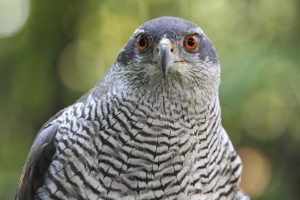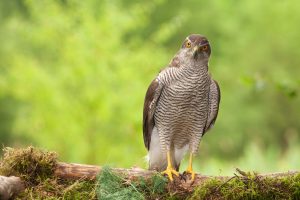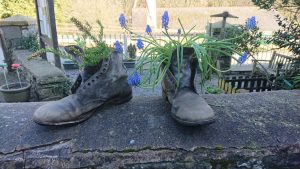As the year comes to an end, I have been thinking about ‘the ones that got away’ in 2022 – birds I haven’t managed to see this year. A notable omission is the Northern goshawk (Accipiter gentilis). So I thought I’d do a little reading around the subject and share it here – including memories from when I have seen these magnificent birds.
The Northern goshawk’s Latin name means ‘noble hawk’, which is said to relate to the fact that, in the Middle Ages, only nobles could fly them. In Old English, the name means ‘goose hawk’, as the birds were said to prey on geese – which gives a good estimation of their size! More usual prey includes corvids, woodpigeons, squirrels and rabbits, with the female being able to take larger prey than the male as she is around 25% bigger than him. The goshawk also predates other raptors and owls, including long-eared owls.
As with other raptor species, their eyes indicate their age: from baby blue for the nestlings, to grey-green at fledging, yellow over the first year, amber in older birds, then, finally, the ruby red of the adults. A life reflected in an iris.
Above this startling eye, it has a ferocious white supercilium (eyebrow) – what I think of as its ‘go-fiercer stripe’! Its breast is barred (leading to some misidentification with the sparrowhawk, but the goshawk is much larger) and its back is a dull grey – males and juveniles are browner; and it has long yellow legs and strong talons, which help it to grasp prey in flight.
If you want to see a goshawk, Wales and the North of England are the best places – look for dense woodland habitat, e.g., large woodlands and forests, with glades and paths for them to hunt along. The bird’s broad wings help it hunt at speed, weaving in and out of the dense woodland where it catches the majority of its prey, and where it also nests. A pair may have a number of nests in their territory and choose between them each year. Once they do settle down, they have between two and four chicks, which all hatch at the same time, so there is no size difference at this stage – unlike in the barn owl, for example.
I have seen them in late winter (late February-early March) skydancing near the RSPB reserve at Lake Vyrnwy in Powys, an amazing sight. The last time (shockingly – where have nearly four years gone!) was 27th February 2019 – a beautiful day of sunshine and clear, deep blue skies. If you climb up through the woods, you eventually find yourself overlooking a valley, with raptors flying almost past your nose. This particular day, they were so close that I could see their fluffy white coverts (which they fluff out as a display gesture to attract a mate). There are around 280-340 resident breeding pairs in the UK, and, as well as the Welsh adults, I was lucky enough to see a juvenile in Perthshire, Scotland, last autumn.
I also saw my first common crossbills on that day in Powys in 2019, and spent some time in the RSPB hide watching the more usual ‘garden’ birds going to and from the bird feeders. A truly memorable day’s birdwatching.
If you want to learn more about the goshawk, James Aldred’s Goshawk Summer (https://www.jamesaldred.com/book-1) is highly recommended – a book I’ve not yet read but is on my ‘wish list’ to remind me of what I have missed by not seeing this bird in 2022!
Sources of additional information: the RSPB website (https://www.rspb.org.uk/birds-and-wildlife/wildlife-guides/bird-a-z/goshawk/) and the Woodland Trust website (https://www.woodlandtrust.org.uk/trees-woods-and-wildlife/animals/birds/goshawk/)





